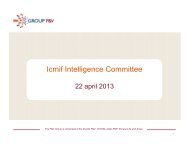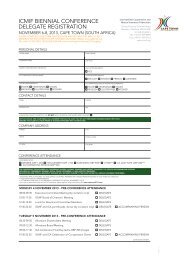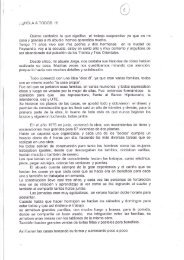Current State of the Market - icmif
Current State of the Market - icmif
Current State of the Market - icmif
You also want an ePaper? Increase the reach of your titles
YUMPU automatically turns print PDFs into web optimized ePapers that Google loves.
MORO 2012<br />
<strong>Current</strong> state <strong>of</strong> <strong>the</strong> reinsurance market<br />
Paddy Jago<br />
May 2012
The current state <strong>of</strong> <strong>the</strong> reinsurance<br />
market<br />
• External factors<br />
• Where are we in <strong>the</strong> market cycle?<br />
• What this means for Mutuals<br />
• Addressing <strong>the</strong>se issues<br />
2
MORO 2012<br />
<strong>Current</strong> state <strong>of</strong> <strong>the</strong> reinsurance market<br />
External factors
External factors<br />
Economic crisis &<br />
Sovereign Debt<br />
Regulatory<br />
Change<br />
Reinsurance<br />
<strong>Market</strong><br />
Catastrophe<br />
Losses<br />
Catastrophe model<br />
change<br />
4
Economic Crisis & Sovereign Debt<br />
• Economic Crisis<br />
– Asset impairment<br />
– Investment difficulties<br />
– … but no evidence that traditional re/insurance holds systemic risks<br />
• Impact <strong>of</strong> <strong>the</strong> Eurozone Debt Crisis on Insurer Solvency?<br />
– Implicit and explicit threats to insurer security<br />
– Issues if one or more sovereigns exiting <strong>the</strong> Euro<br />
– But … <strong>the</strong> sector has proven itself resilient<br />
• Insurers are different from Banks<br />
– Insurers are significant investors in Eurozone sovereign / financial sector<br />
debt;<br />
– However, exposure differs from banks in many key respects<br />
5
Catastrophic losses<br />
- Events <strong>of</strong> 2011<br />
Source: MR NatCatSERVICE<br />
6
Catastrophic losses<br />
- Most Costly World Insurance Losses, 1970-2011<br />
50<br />
45<br />
Source; Sources: Swiss Re sigma 1/2011; Munich Re; Insurance Information Institute research.<br />
40<br />
Insured Loss (USDm)<br />
35<br />
30<br />
25<br />
20<br />
15<br />
10<br />
5<br />
0<br />
Hurricane Hugo<br />
(1989)<br />
Winter Storm Daria<br />
(1991)<br />
Chile Quake (2010)<br />
Hurricane Ivan<br />
(2004)<br />
Typhoon Mirielle<br />
(1991)<br />
Charley (2004)<br />
Thailand Floods<br />
(2011)<br />
Wilma (2005)<br />
New Zealand<br />
Quake (2011)<br />
Hurricane Ike<br />
(2008)<br />
Northridge EQ<br />
(1994)<br />
Spring Tornadoes/<br />
Storms (2011)<br />
WTC Terror Attack<br />
(2001)<br />
Hurricane Andrew<br />
(1992)<br />
Japan Quake,<br />
Tsunami (2011)<br />
Hurricane Katrina<br />
(2005)<br />
1970 - 2010 2011<br />
7
Catastrophic losses<br />
- 1988 to 2011<br />
140,000<br />
Source; Swiss Re Economic Research & Consulting<br />
120,000<br />
100,000<br />
Insured Loss (USDm)<br />
80,000<br />
60,000<br />
40,000<br />
20,000<br />
0<br />
1988<br />
1989<br />
1990<br />
1991<br />
1992<br />
1993<br />
1994<br />
1995<br />
1996<br />
1997<br />
1998<br />
1999<br />
2000<br />
2001<br />
2002<br />
2003<br />
2004<br />
2005<br />
2006<br />
2007<br />
2008<br />
2009<br />
2010<br />
2011<br />
Wea<strong>the</strong>r-related Earthquake/tsunami Man-made disasters<br />
8
Catastrophic losses<br />
Event Loss (USD) Issue<br />
Australia Floods<br />
3 bn<br />
Little modelling or exposure<br />
monitoring<br />
Japan EQ & Tsunami 35 bn Only partially modelled<br />
US Tornadoes 19 bn Extreme frequency<br />
New Zealand EQ 20 bn Significant modelling issues<br />
• 2011; <strong>the</strong> highest loss year on record<br />
for economic losses<br />
– USD 380bn in economic losses<br />
globally<br />
– USD 270bn in 2005 previous<br />
highest<br />
• USD 105 bn in insured losses globally<br />
– 2 nd only to 2005 (inflation<br />
adjusted)<br />
– > 5x 30 year average <strong>of</strong> USD<br />
19bn<br />
Hurricane Irene 4 bn Extreme flooding<br />
Thailand<br />
12 bn<br />
Little modelling or exposure<br />
monitoring<br />
9
Catastrophic losses<br />
- What have we learned?<br />
• Insured losses still a small percentage <strong>of</strong> economic loss<br />
– An long-term <strong>the</strong>me that commercial insurers struggle to address<br />
– Opportunity for <strong>the</strong> cooperative movement<br />
• The “tail is always bigger than we think<br />
• It’s easy to understate “time element” losses<br />
– Denial <strong>of</strong> access<br />
– Business Interruption<br />
– Contingent Business Interruption<br />
• A global contagion?<br />
Sendai Airport, source; National Geographic<br />
• Catastrophe models have under-performed<br />
– Coverage<br />
– Secondary and contributing perils<br />
Source; NOAA<br />
10
Model change<br />
• Catastrophe models change frequently<br />
– New science, new loss experience<br />
– RMS v11 Europe Windstorm<br />
• Hazard increases<br />
• Explicit clustering<br />
– RMS v11 US Hurricane<br />
• Medium Term Rates<br />
• Storm surge<br />
• In-land filling<br />
• 2011 saw an unprecedented level <strong>of</strong> change<br />
– Especially in Europe & USA<br />
– Around 250 new or upgrades from a total <strong>of</strong> 450 territory peril<br />
combinations<br />
• Model change affects<br />
– Underwriting & business planning<br />
– Portfolio management<br />
– Reinsurance purchasing<br />
– Capital management<br />
– Regulatory<br />
v10<br />
v11<br />
11
Regulatory Change<br />
• Regulatory change is everywhere<br />
– But felt most acutely as a result <strong>of</strong> SII<br />
• Regulation is becoming global<br />
– A spreading <strong>of</strong> good and bad regulatory ideas?<br />
• Will this result in<br />
increased understanding <strong>of</strong> risk?<br />
A clean-up <strong>of</strong> poorly capitalised companies?<br />
best practice and better understanding <strong>of</strong> cat<br />
models?<br />
• But at what cost?<br />
Increased consumer costs<br />
Increased reinsurance costs<br />
Enormous regulatory burden<br />
12
ICMIF Solvency II Solutions<br />
One Day Seminar<br />
• WHEN: May 24, 2012<br />
• WHERE: Willis Re, The Willis Building, 51 Lime Street, London,<br />
EC3M 7DQ, UK<br />
• HOSTED BY: ICMIF Supporting Members<br />
• REGISTER NOW: http://www.<strong>icmif</strong>.org/solvency2012<br />
– Managing Insurance Risk for Pr<strong>of</strong>it<br />
– Being Ahead <strong>of</strong> <strong>the</strong> Curve in Asset Management<br />
– Optimising Internal Risk Management Practices beyond<br />
Solvency II Compliance Requirements<br />
– Rating Agency and Political Perspectives on Transparency<br />
and Reporting<br />
• Speakers<br />
– Jonathan Evans, MP - key note speaker<br />
– A.M. Best Europe, INVESCO, PartnerRe, Risk Dynamics &<br />
Willis Re<br />
13
MORO 2012<br />
Where are we in <strong>the</strong> market cycle?
Where are we in <strong>the</strong> market cycle?<br />
- Selected recent renewals<br />
Territory<br />
Loss free<br />
excess <strong>of</strong> loss<br />
Loss affected<br />
excess <strong>of</strong> loss<br />
Comments<br />
Australasia +15 to +35% +40% to +75%<br />
Australasia (inc. NZ) - +80 to +150%<br />
Significant losses<br />
China 0% to +15% - EQ exposure driving pricing<br />
Europe +1% to +4% -<br />
France 0% to +3% -<br />
Broadly loss free, o<strong>the</strong>r than Nordic<br />
Nordic +5% to +10% +25% to +50%<br />
Japan +20% to +30% +30% to +50% In addition to prior year increases<br />
Taiwan > +30% - Concern over EQ and CBI<br />
US Nationwide +2.5% to +10% - Losses and model change<br />
15
Where are we in <strong>the</strong> market cycle?<br />
• Where are we in <strong>the</strong> market cycle<br />
– AM Best “Critically, <strong>the</strong> market seems poised for a<br />
turn” January 2012<br />
– Hardening in response to major losses<br />
– … but only spotty increases in loss free territories<br />
• Reinsurers under pressure<br />
– USD 50 bn <strong>of</strong> losses to <strong>the</strong> reinsurance sector in 2<br />
years<br />
– Manageable from a capital perspective<br />
– <strong>Market</strong>’s capital remains strong for 2012<br />
• Not a “proper” hard market<br />
– No dislocation<br />
– Capacity remains available<br />
– Little in <strong>the</strong> way <strong>of</strong> capital impairment<br />
Estimated <strong>Market</strong> Capitalisation<br />
500 bn<br />
450 bn<br />
400 bn<br />
350 bn<br />
• Are we entering an era <strong>of</strong> “Micro-cycles”?<br />
300 bn<br />
– Dependant on line <strong>of</strong> business<br />
– Dependant on geography<br />
– Not necessarily industry-wide<br />
250 bn<br />
2007 2007-<br />
2008<br />
2008-<br />
2009<br />
2009-<br />
2010<br />
2010-<br />
2011<br />
2011<br />
16
Reinsurance market cycles<br />
Loss <strong>of</strong> capital<br />
Rates Rise<br />
Greater<br />
pr<strong>of</strong>itability<br />
New capital<br />
attracted<br />
Pricing<br />
decreases<br />
Catastrophes<br />
Reserve erosion<br />
Underwriting losses<br />
Asset impairment<br />
Traditional market cycles<br />
• Reactive to major market events<br />
• High barriers to entry<br />
• Multi-year cycles<br />
17
Reinsurance market cycles<br />
Rates Rise<br />
Rates Rise<br />
New capital attracted<br />
Greater<br />
pr<strong>of</strong>itability<br />
<strong>Market</strong> flattens<br />
New capital<br />
attracted<br />
Pricing<br />
decreases<br />
Pricing<br />
decreases<br />
Is <strong>the</strong>re still a macro cycle?<br />
• Reduced barriers to entry<br />
• New products and investment strategies<br />
• New capital anticipates market hardening<br />
• Continued over-capitalisation<br />
18
MORO 2012<br />
<strong>Current</strong> state <strong>of</strong> <strong>the</strong> reinsurance market<br />
What this means for Mutuals
Universal qualities <strong>of</strong> mutuals<br />
Focus and homogeneity<br />
• Homogeneity<br />
• Focus on one market segment<br />
• No incentive to move in and out<br />
<strong>of</strong> product lines<br />
• Highly motivated to remain<br />
relevant to membership<br />
• Explains extraordinary focus on<br />
product and service when<br />
compared to for pr<strong>of</strong>it market<br />
Focus<br />
20
Universal qualities <strong>of</strong> mutuals<br />
Commitment to Policyholders<br />
• Unrivalled product and customer<br />
support<br />
• Long term perspective<br />
• Maintain availability <strong>of</strong><br />
appropriate limits<br />
• Realistic pricing – <strong>of</strong>ten in <strong>the</strong><br />
face <strong>of</strong> bitter commercial market<br />
competition<br />
• Dividends when results exceed<br />
expectations<br />
Focus<br />
Commitment<br />
21
Universal qualities <strong>of</strong> mutuals<br />
Consistent value over time<br />
• Maintaining coverage and limits<br />
at lowest sustainable price<br />
• Reduced loss costs through<br />
cutting edge loss prevention<br />
• Reduce claims costs with<br />
specialist expertise<br />
• For pr<strong>of</strong>it markets have moved in<br />
and out at whim<br />
Focus<br />
Commitment<br />
Consistency<br />
22
Universal qualities <strong>of</strong> mutuals<br />
Unrivalled service<br />
• Tailored products, adapted as<br />
needed<br />
• Intimate knowledge <strong>of</strong>, and direct<br />
communication with members<br />
• The “for pr<strong>of</strong>it” market serves<br />
multiple constituencies and<br />
cannot match service level<br />
Focus<br />
Service<br />
Commitment<br />
Consistency<br />
23
Challenges faced by mutuals<br />
Relentless<br />
competition<br />
Smaller size<br />
Outside<br />
Insurance<br />
market<br />
mainstream<br />
Concentration<br />
<strong>of</strong> risk<br />
Stakeholder<br />
balance<br />
24
What this means for Mutuals<br />
Relentless competition Reinsurance shouldn’t restrict <strong>the</strong> coverage you give<br />
Outside Insurance market mainstream Reinsurance relationships should inform, not be transactional<br />
Equity between different stakeholders Consistent approach to underwriting<br />
Working with one affinity group Risk concentration need reinsurance to manage peaks<br />
Smaller Size Capital is precious<br />
Mutuals need preferred treatment when accessing<br />
Reinsurance capital<br />
25
MORO 2012<br />
<strong>Current</strong> state <strong>of</strong> <strong>the</strong> reinsurance market<br />
Addressing <strong>the</strong>se issues
Addressing <strong>the</strong>se issues<br />
• Diversification<br />
• Mutual reinsurers<br />
• Multi Year reinsurance<br />
• Pooling Risk<br />
27
Diversification<br />
• We have chosen this week to launch a new report;<br />
Diversification challenges and opportunities for Mutuals<br />
• Key lessons; pursue diversification only where<br />
– It is in line with <strong>the</strong> long-term aims <strong>of</strong> <strong>the</strong><br />
organisation<br />
– Stands a reasonable chance <strong>of</strong> being pr<strong>of</strong>itable<br />
– Does not come at <strong>the</strong> expense <strong>of</strong> a loss <strong>of</strong> focus<br />
on o<strong>the</strong>r aspects <strong>of</strong> business<br />
28
Mutual reinsurers<br />
• Like minded partners<br />
– Significant financial strength already<br />
within <strong>the</strong> movement<br />
– Starting on <strong>the</strong> same page<br />
– A long history <strong>of</strong> service<br />
– No need to explain who you are<br />
29
Multi Year reinsurance<br />
Year 1 <strong>of</strong> 3<br />
Year 2 <strong>of</strong> 3 Year 3 <strong>of</strong> 3<br />
Open market reinsurance Open market reinsurance Open market reinsurance<br />
Multi-year<br />
(1 <strong>of</strong> 3)<br />
Single<br />
Year<br />
Multi-year<br />
(2 <strong>of</strong> 3)<br />
Multi-year<br />
(1 <strong>of</strong> 3)<br />
Single<br />
Year<br />
Multi-year<br />
(3 <strong>of</strong> 3)<br />
Multi-year<br />
(2 <strong>of</strong> 3)<br />
Multi-year<br />
(1 <strong>of</strong> 3)<br />
Retention Retention Retention<br />
30
Pooling Risk<br />
• Good examples already available<br />
– Latin American Reinsurance Group<br />
– Fire Facultative Facility<br />
10.00%<br />
Potential Cost Savings<br />
• Shared XL purchase<br />
– A High Layer Catastrophe Excess <strong>of</strong><br />
Loss<br />
– Joint purchase by 3 – 6 ICMIF members<br />
– Derive cost savings from<br />
Layer Rate on Line<br />
8.00%<br />
6.00%<br />
4.00%<br />
2.10%<br />
2.25%<br />
1.75%<br />
3.13%<br />
• Capital efficiencies from reduction in<br />
“redundant” top layer limits<br />
• Diversification within layer<br />
2.00%<br />
3.00%<br />
6.00%<br />
• Bulk purchasing power<br />
0.00%<br />
• An ICMIF Reinsurer or SPV?<br />
Company A<br />
Company B<br />
Company C<br />
Company D<br />
Potential Savings<br />
Shared Layer<br />
31
Conclusion<br />
• The needs <strong>of</strong> a Mutual insurance company (including reinsurance)<br />
• The current state <strong>of</strong> <strong>the</strong> reinsurance market<br />
• The challenges faced by both<br />
• Working toge<strong>the</strong>r to build reinsurance solutions<br />
A mutual understanding = a mutual future<br />
32
MORO 2012<br />
<strong>Current</strong> state <strong>of</strong> <strong>the</strong> reinsurance market










